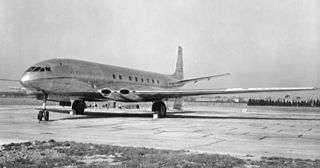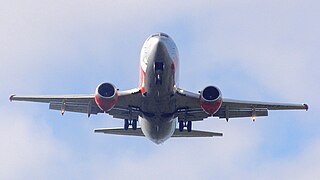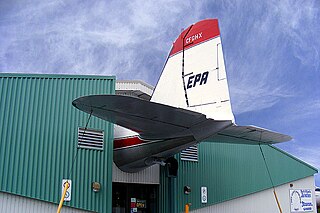
A jet airliner or jetliner is an airliner powered by jet engines. Airliners usually have two or four jet engines; three-engined designs were popular in the 1970s but are less common today. Airliners are commonly classified as either the large wide-body aircraft, medium narrow-body aircraft and smaller regional jet.
Transatlantic crossings are passages of passengers and cargo across the Atlantic Ocean between Europe or Africa and the Americas. The majority of passenger traffic is across the North Atlantic between Western Europe and North America. Centuries after the dwindling of sporadic Viking trade with Markland, a regular and lasting transatlantic trade route was established in 1566 with the Spanish West Indies fleets, following the voyages of Christopher Columbus.

The Extended-range Twin-engine Operations Performance Standards (ETOPS) are safety standards set by the International Civil Aviation Organization (ICAO) for twin-engine commercial passenger aircraft operations. They are a safety measure intended to ensure that in the event of a single engine failure, an aircraft will still be able to reach a diversion airport using the remaining operational engine. This may be at a reduced speed and/or height, and usually applies to flights over water or remote lands, typically routes previously restricted to three- and four-engine aircraft.
RAF Ferry Command was the secretive Royal Air Force command formed on 20 July 1941 to ferry urgently needed aircraft from their place of manufacture in the United States and Canada, to the front line operational units in Britain, Europe, North Africa and the Middle East during the Second World War.
A transatlantic flight is the flight of an aircraft across the Atlantic Ocean from Europe, Africa, South Asia, or the Middle East to North America, Latin America, or vice versa. Such flights have been made by fixed-wing aircraft, airships, balloons and other aircraft.

Gander International Airport is located in Gander, Newfoundland and Labrador, Canada, and is operated by the Gander International Airport Authority. Canadian Forces Base Gander shares the airfield but is a separate entity from the airport. The airport is sometimes referred to as the "Crossroads of the World", and is classified as an international airport by Transport Canada.

Operation Yellow Ribbon was commenced by Canada to handle the diversion of civilian airline flights in response to the September 11 attacks in 2001 in the United States. Canada's goal was to ensure that potentially destructive air traffic be removed from United States airspace as quickly as possible, and away from potential U.S. targets, and instead place these aircraft on the ground in Canada, at military and civilian airports primarily in the Canadian provinces of Nova Scotia, Newfoundland, and British Columbia. Yukon, New Brunswick, Alberta, Manitoba, Ontario, the Northwest Territories, and Quebec also took in aircraft so that any malicious or destructive potential threats could be better contained and neutralized. None of the aircraft proved to be a threat, and Canada hosted thousands of passengers who were stranded until U.S. airspace was reopened.

Bangor International Airport is a joint civil-military public airport on the west side of the city of Bangor, in Penobscot County, Maine, United States. Owned and operated by the City of Bangor, the airport has a single runway measuring 11,440 by 200 ft. Formerly a military installation known as Dow Air Force Base, Bangor International Airport remains home to the 101st Air Refueling Wing of the Maine Air National Guard, although most of the Air Force's aircraft and personnel left in the late 1960s. BGR covers 2,079 acres of land. It is included in the Federal Aviation Administration (FAA) National Plan of Integrated Airport Systems for 2023–2027 categorized it as a non-hub primary commercial service facility.

The Jet Age is a period in the history of aviation defined by the advent of aircraft powered by jet turbine engines and the social and cultural changes fostered by commercial jet travel.

Bluie West One, later known as Narsarsuaq Air Base and Narsarsuaq Airport, was built on a glacial moraine at what is now the village of Narsarsuaq, near the southern tip of Greenland. Construction by the United States Army began in June 1941. The first aircraft landed there in January 1942, as a link in the North Atlantic air ferry route in World War II. The base had a peak population of about 4,000 American servicemen, and it is estimated that some 10,000 aircraft landed there en route to the war in Europe and North Africa.

Iqaluit Airport serves Iqaluit, Nunavut, Canada and is located adjacent to the city. It hosts scheduled passenger service from Ottawa, Montreal, Rankin Inlet, and Kuujjuaq on carriers such as Canadian North, and from smaller communities throughout eastern Nunavut. It is also used as a forward operating base by the Royal Canadian Air Force (RCAF). In 2011, the terminal handled more than 120,000 passengers.

Stephenville Dymond International Airport is an airport located 1 nautical mile south southeast of Stephenville, Newfoundland and Labrador, Canada. It was built by the United States Army Air Forces and operated as Ernest Harmon Air Force Base from 1941 to 1966.

Kuujjuaq Airport is an airport located 1.5 nautical miles southwest of Kuujjuaq, Quebec, Canada.

A twinjet or twin-engine jet is a jet aircraft powered by two engines. A twinjet is able to fly well enough to land with a single working engine, making it safer than a single-engine aircraft in the event of failure of an engine. Fuel efficiency of a twinjet is better than that of aircraft with more engines. These considerations have led to the widespread use of aircraft of all types with twin engines, including airliners, fixed-wing military aircraft, and others.

Wilmington Airport is an airport located in unincorporated New Castle County, Delaware, near Wilmington, Delaware. Owned by New Castle County and operated under a lease agreement with the Delaware River and Bay Authority, it is five miles (8 km) south of Wilmington and about 30 miles (50 km) from Philadelphia, Pennsylvania. It is included in the Federal Aviation Administration (FAA) National Plan of Integrated Airport Systems for 2017–2021, in which it is categorized as a non-hub primary commercial service facility.

Narsarsuaq Airport is an airport located in Narsarsuaq, a settlement in the Kujalleq municipality in southern Greenland. Along with Kangerlussuaq Airport, it is one of two airports in Greenland capable of serving large airliners. It is also the only international airport in southern Greenland. The settlement it serves is small, with the airport primarily functioning as a transfer point for passengers heading for the helicopter hubs of Air Greenland in Qaqortoq and Nanortalik. The airport is due to be closed in late 2026 when Qaqortoq Airport is scheduled to open.

The North Atlantic Aviation Museum is an aviation museum located in the town of Gander, Newfoundland and Labrador, Canada.
A polar route is an aircraft route across the uninhabited polar ice cap regions. The term "polar route" was originally applied to great circle navigation routes between Europe and the west coast of North America in the 1950s.

AirTanker Services Limited, incorporated in England and Wales on 14 June 2007 with the company registration number 06279646, is a private limited company in the United Kingdom (UK), which operates a British airline known as AirTanker, and is also an aircraft leasing and operating company.

On 11 September 1990, a Faucett Perú Boeing 727 airliner, registered OB-1303, disappeared in an area of the Atlantic Ocean approximately 180 miles southeast of Cape Race, Newfoundland, Canada. The aircraft was being ferried back from Malta to Peru after having been leased to Air Malta, and had six crewmembers on board as well as ten passengers consisting of airline employees and their families. The last contact with the crew was a distress message stating that the aircraft had run out of fuel and that they were preparing to ditch. The aircraft was hundreds of miles off course at the time. Nothing more was ever heard from the flight, and no trace of the aircraft or any of the occupants has since been found.
















